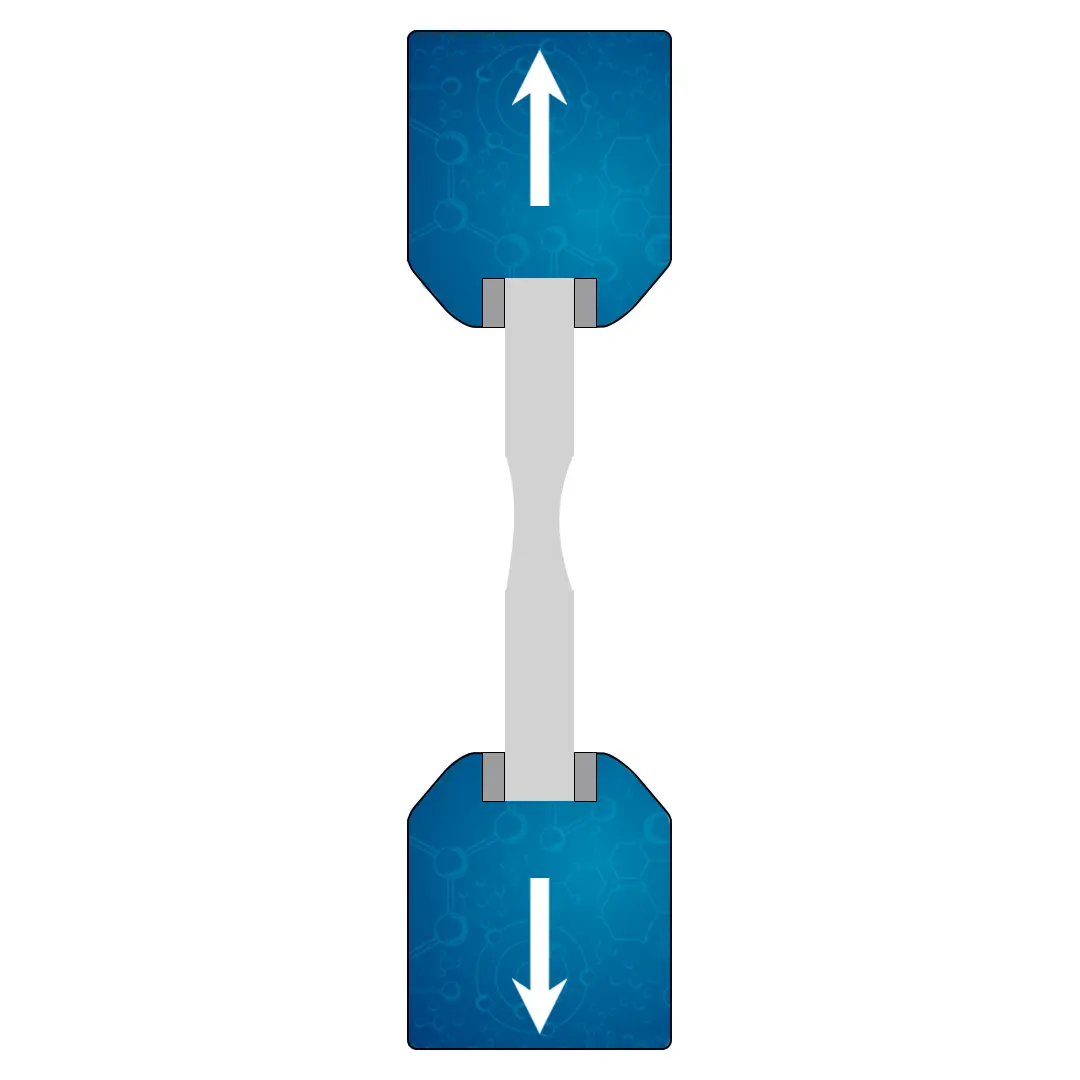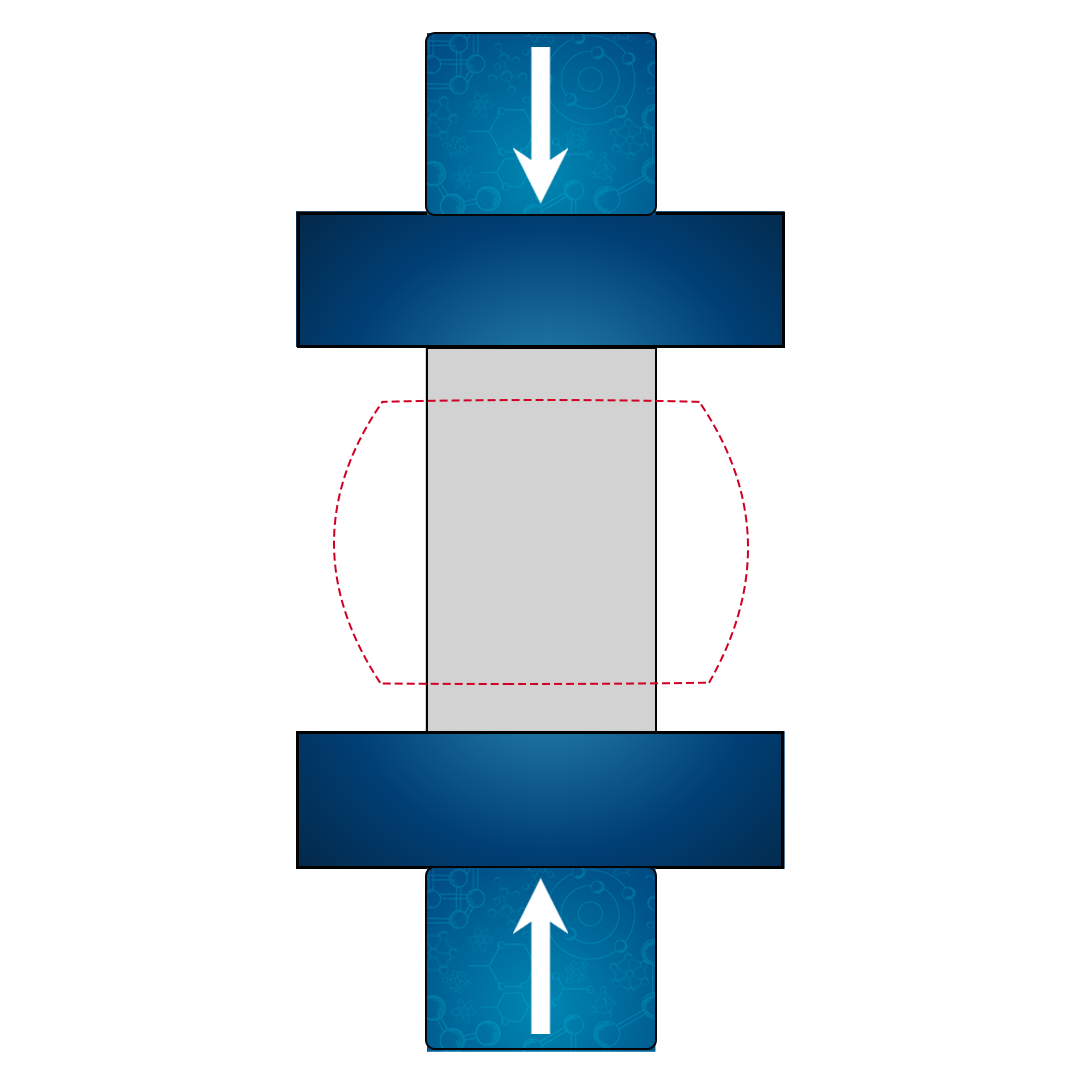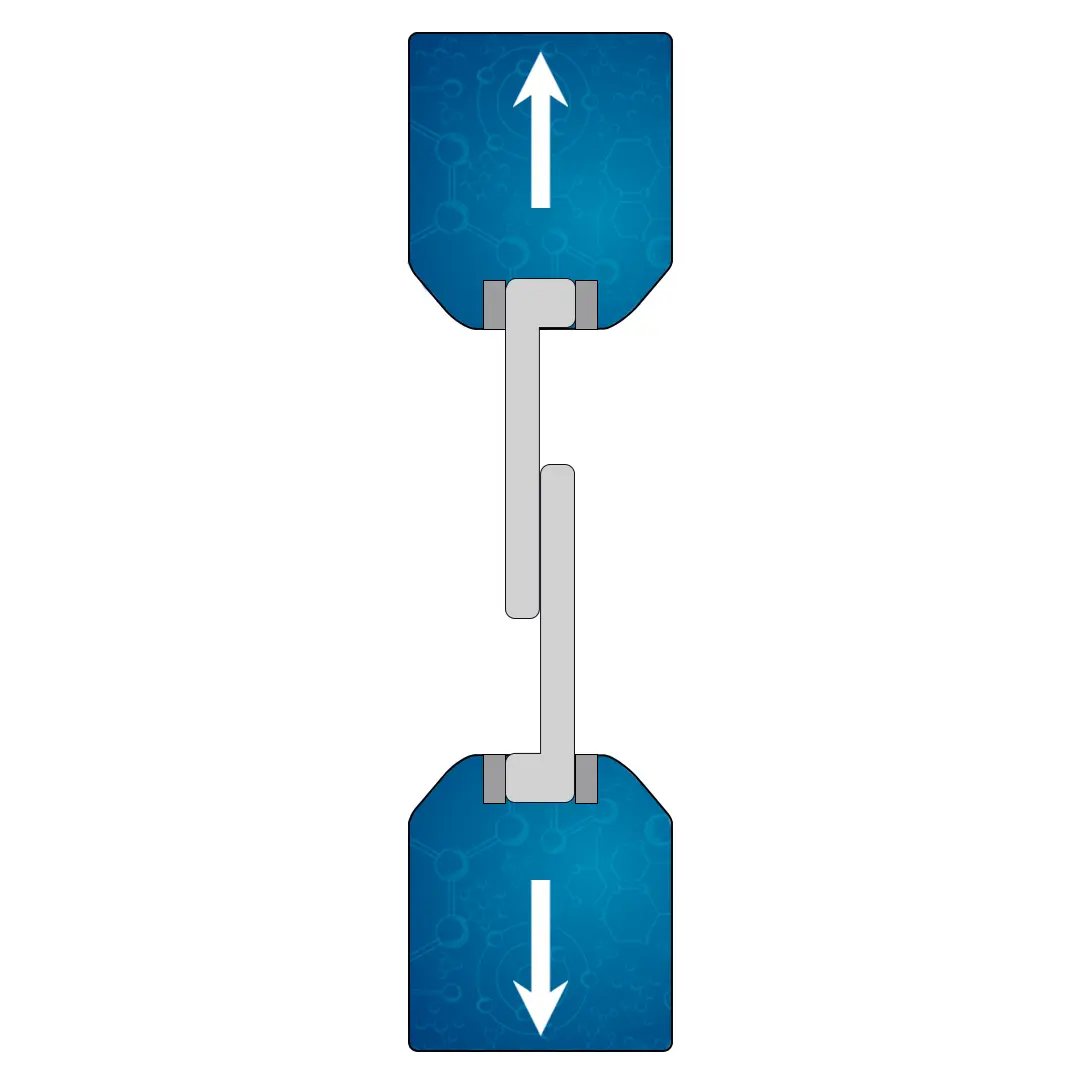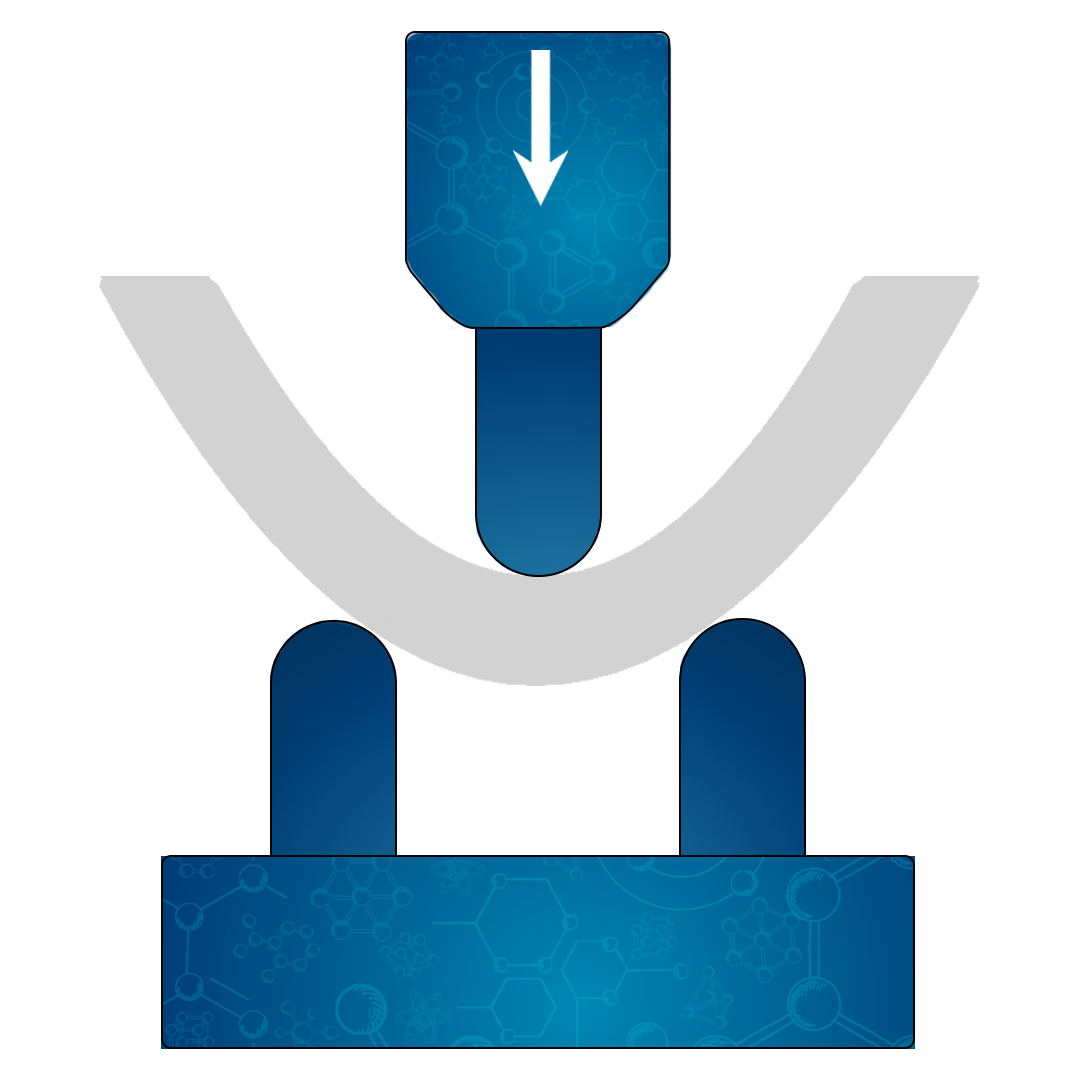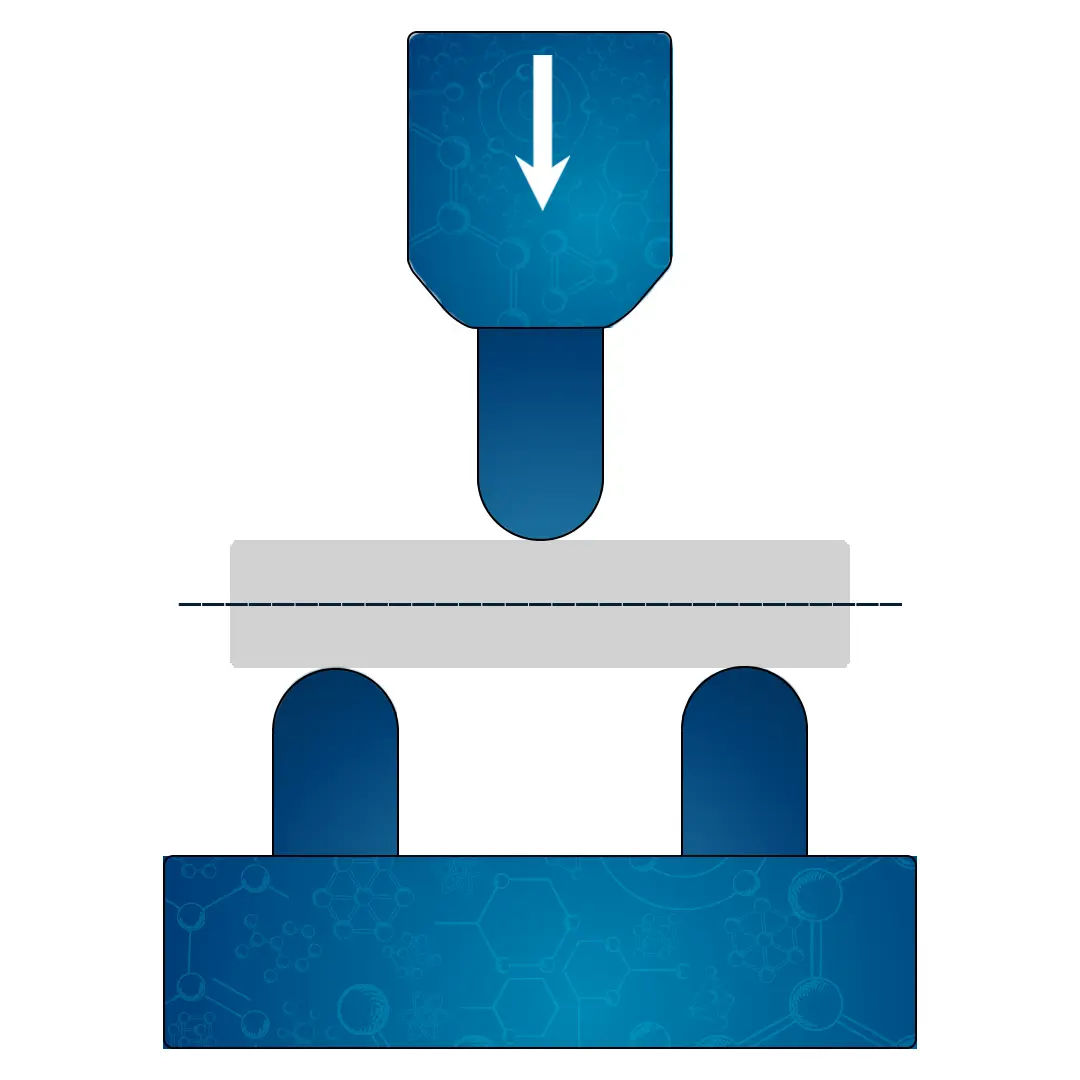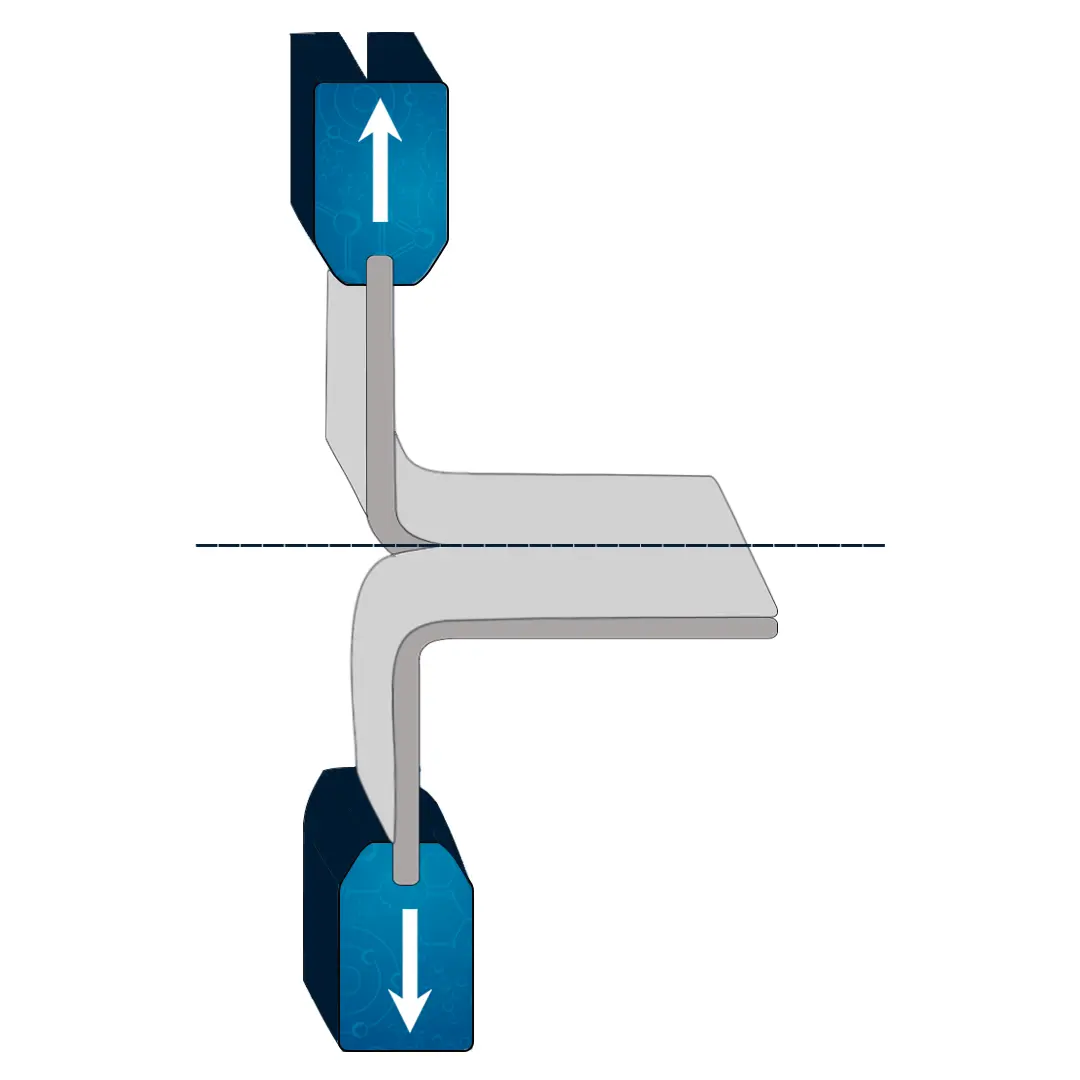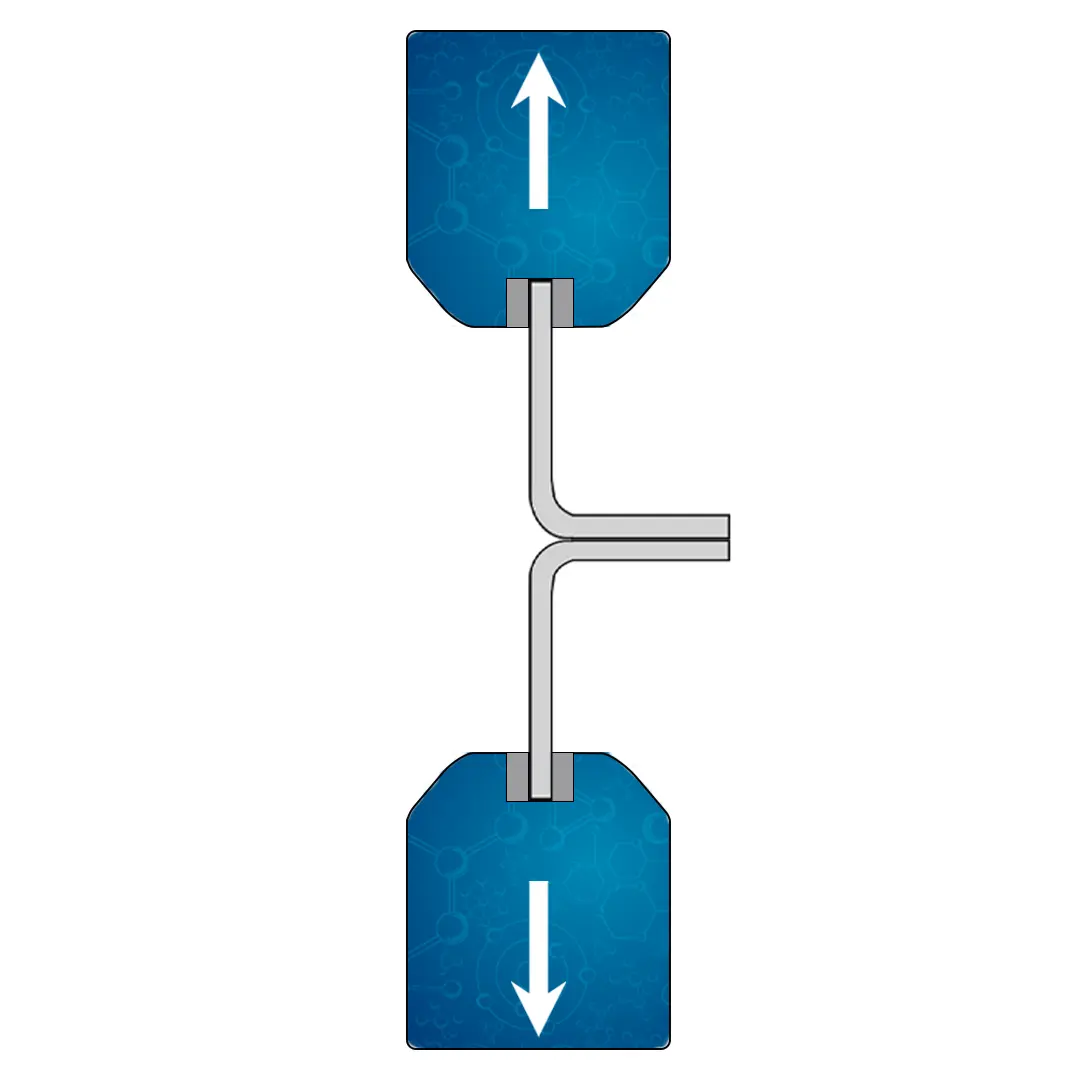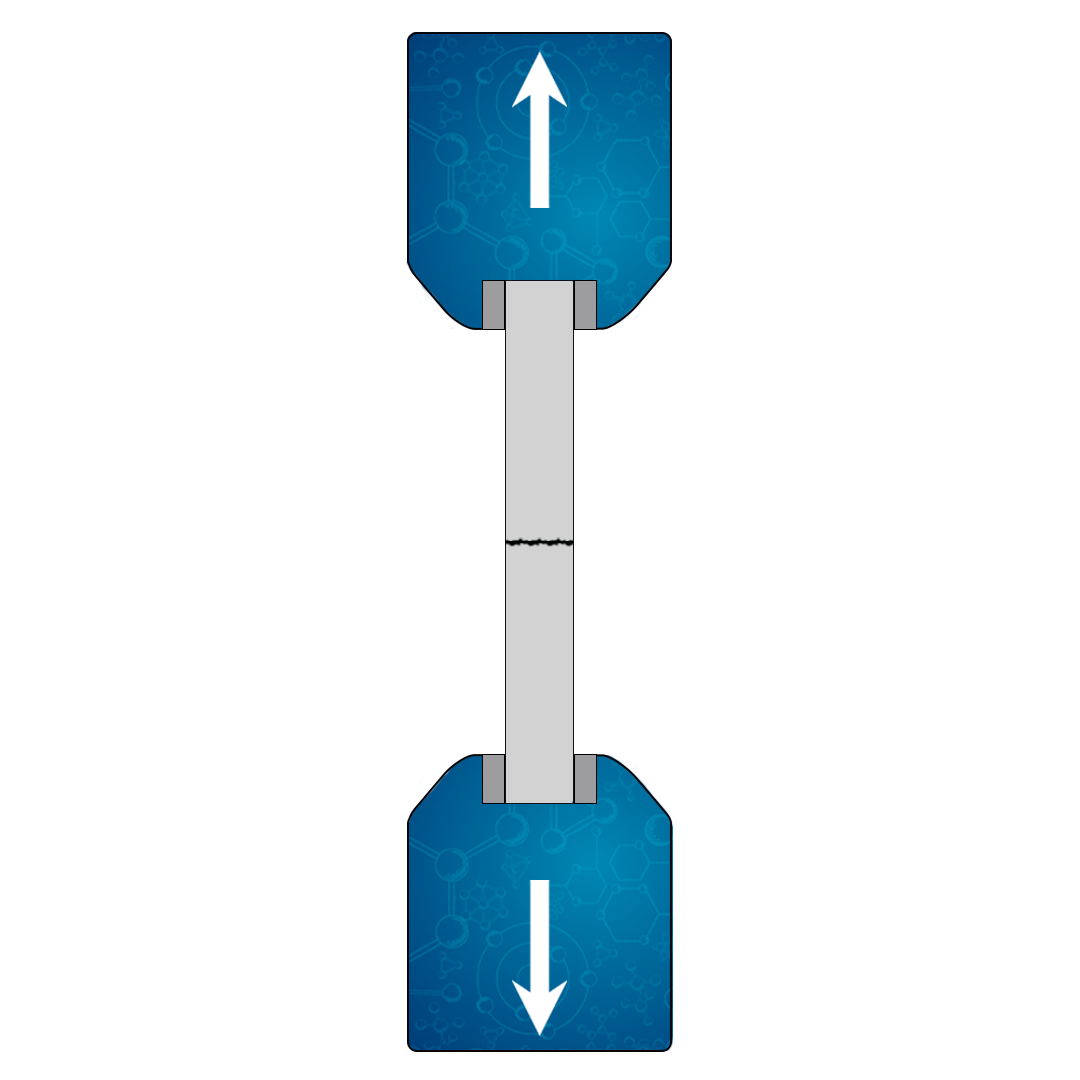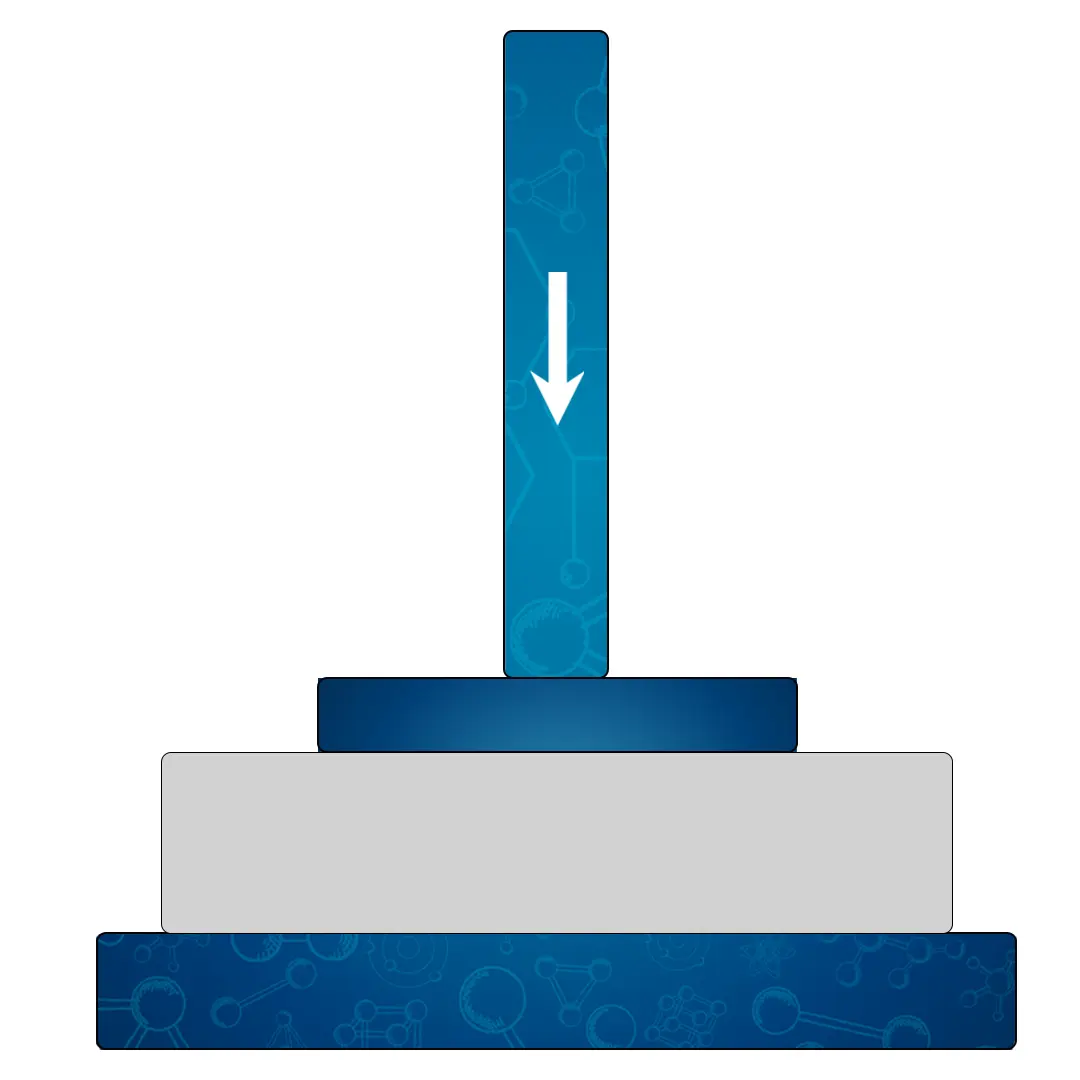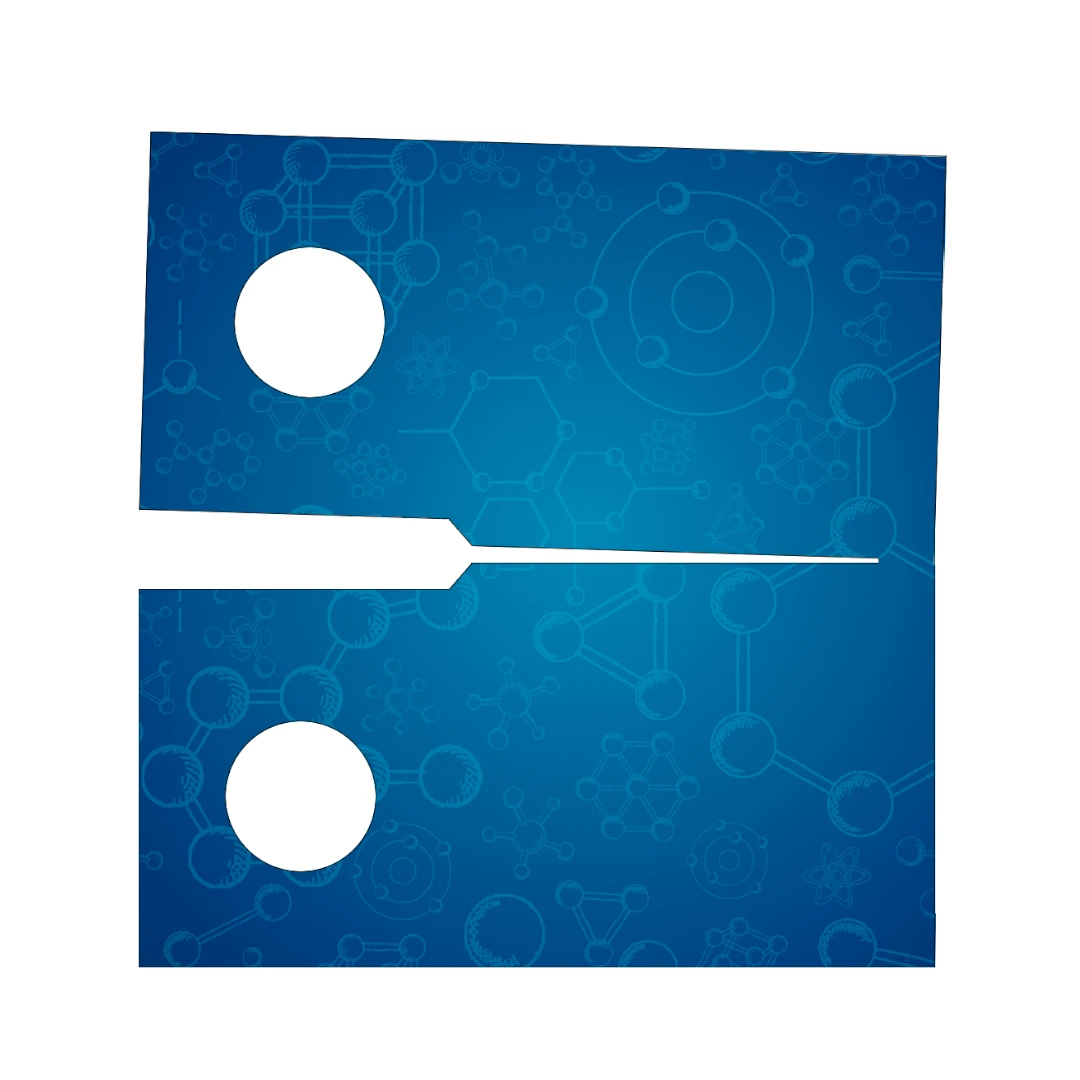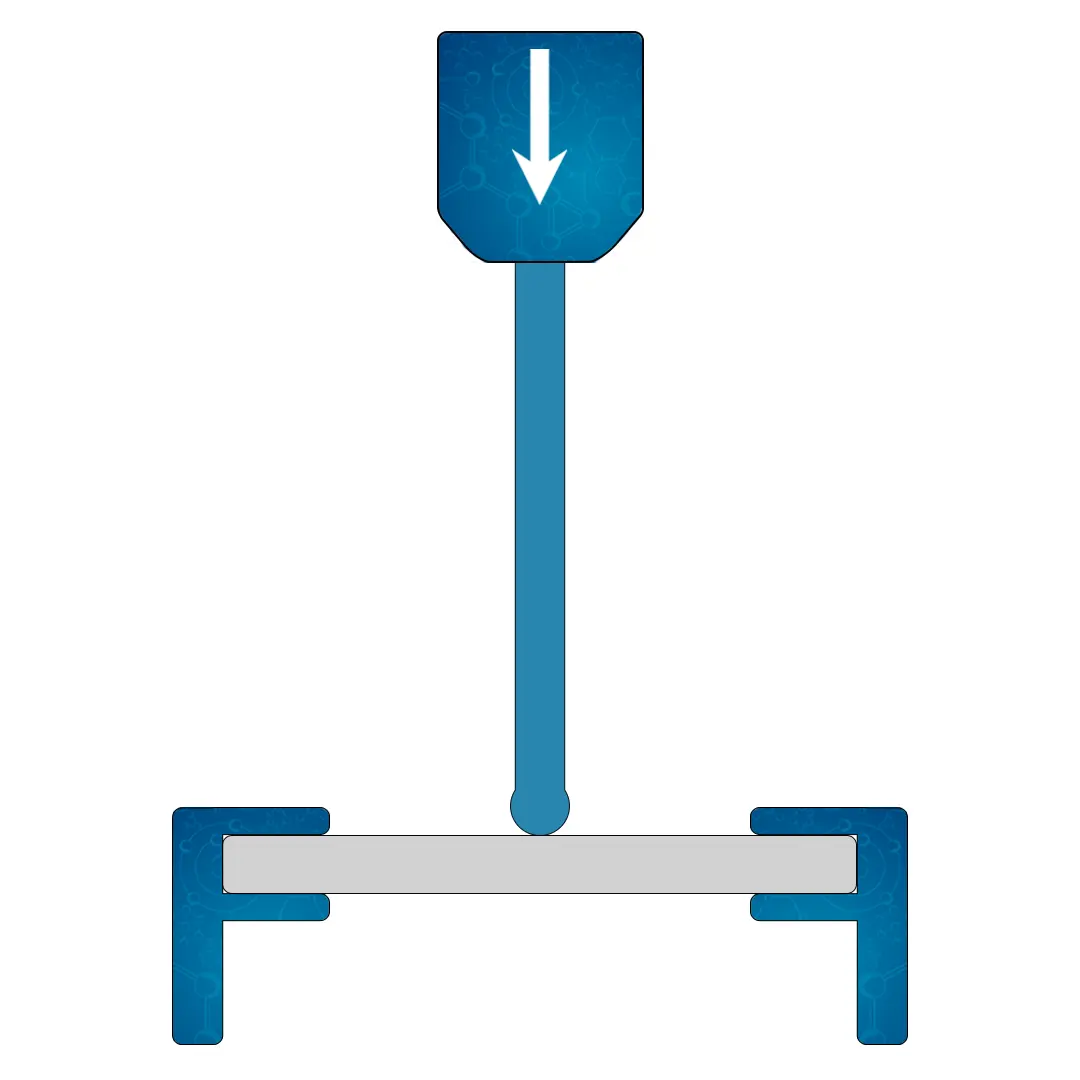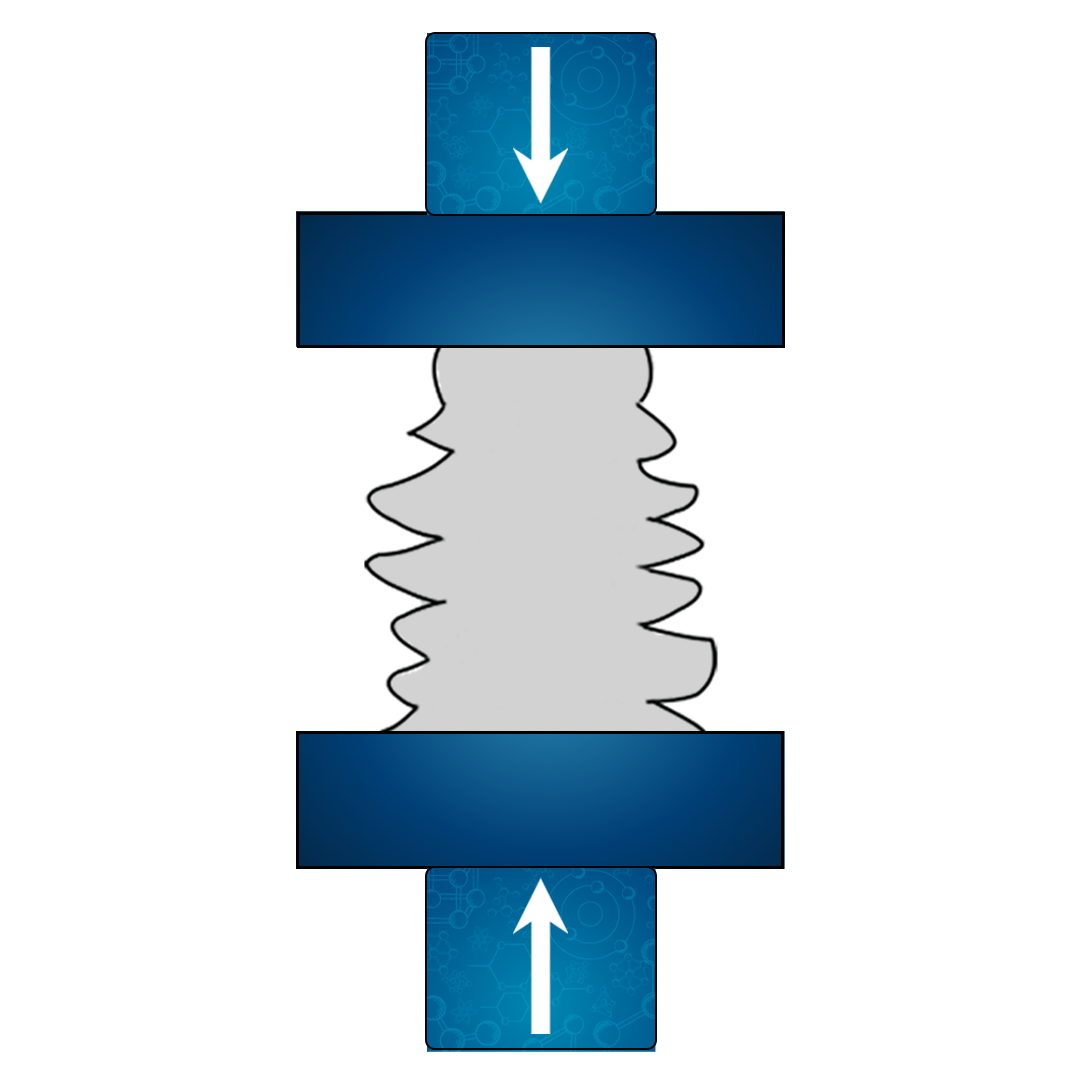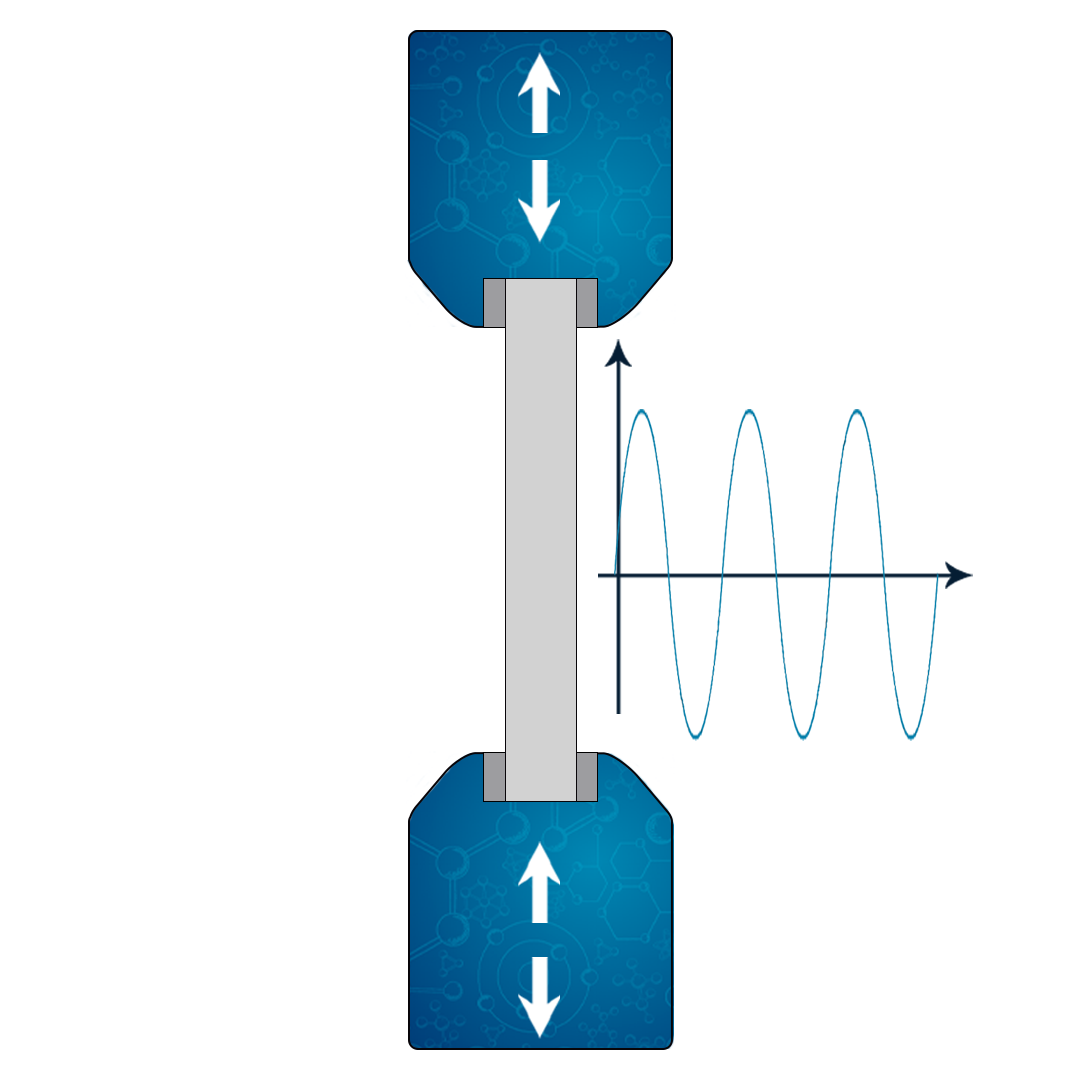Bend Testing: Evaluation of Strength and Ductility of Materials
The bending test is one of the main mechanical tests used in engineering and materials science to evaluate the flexural strength and ductility of different types of materials. In this article, we will cover in detail the bending test, exploring its definition, importance, advantages, obtained properties, applications and much more.
In the following text, you will find a summary of the topics that will be addressed in this article.
What is the Bend Testing?
The bending test is a mechanical test used to evaluate the resistance of a material to plastic deformation caused by repeated bending. In this test, a sample of the material is subjected to bending forces until failure occurs. The objective is to determine the ability of the material to withstand bending without fracturing.
This test is performed by applying a load to a specific region of the sample, causing the material to flex. The load is gradually increased until fracture or cracking failure occurs. During the test, parameters such as the applied load, the deformation and the bending angle reached before failure are recorded.
Bending testing is widely used to determine the ductility and toughness of materials. Ductility refers to the material’s ability to plastically deform without fracturing, while toughness measures the material’s resistance to impact fracture.
Through this test, it is possible to evaluate the material’s ability to resist repeated plastic deformations, such as those found in several practical applications. This information is essential for the proper selection of materials in engineering projects, ensuring the safety and durability of structures and components.
The bending test can be performed on different types of materials, such as metals, polymers, ceramics and composites. Each material can present different behaviors during the test, allowing a more precise analysis of its properties.
In summary, the bending test is an important technique in the area of engineering and materials science, as it allows evaluating the ability of a material to withstand repeated plastic deformations without fracture. It is an essential test to determine the strength and ductility of materials, aiding in the proper selection for various applications.

Guided bending scheme
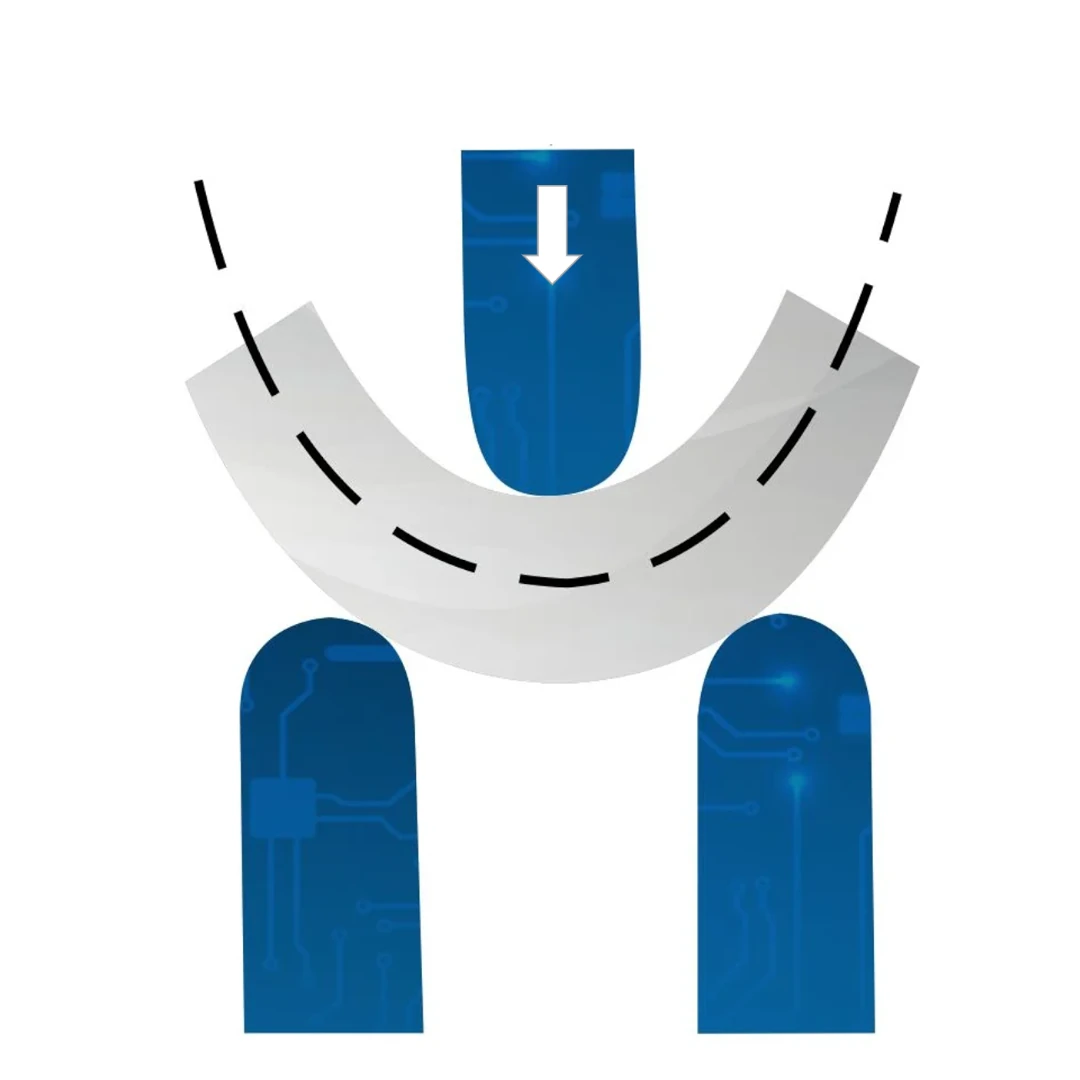
Guided bending scheme
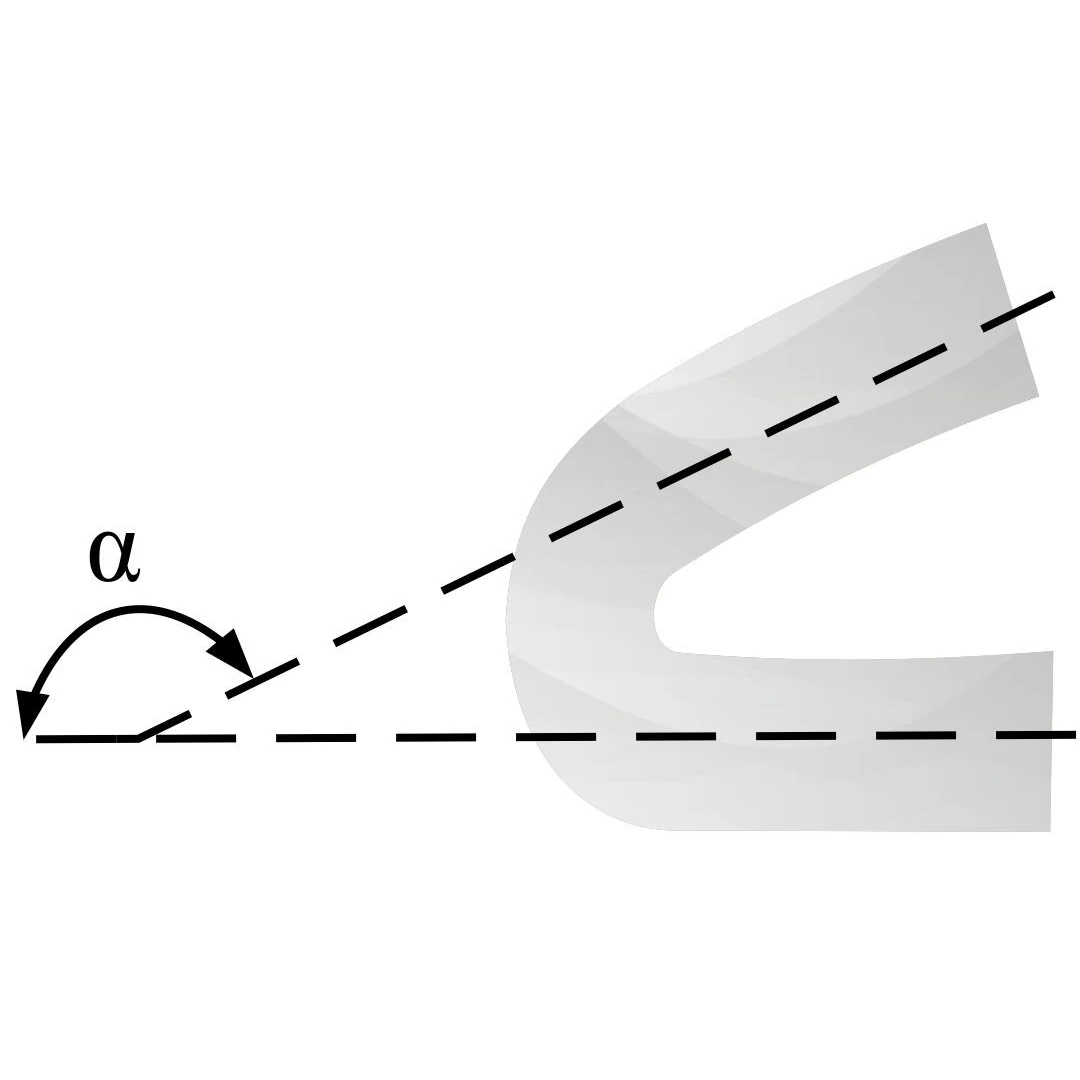
Bending Angle (alpha)
Differences Between a Flexural Testing and Bend Testing
Flexural testing and bend testing are closely related and often used interchangeably in the field of material science, as both tests are designed to assess a material’s behavior under bending or flexural stress. However, they do have slight differences that can impact their usage and the type of information they provide:
Definition & Focus:
- Flexural Testing: Also known as a bending test, flexural testing is a method for determining the behavior of materials subjected to bending loads or flexural stress. The main focus of flexural testing is to measure flexural strength and flexural modulus. It is a type of destructive testing and is typically performed using a three-point or four-point bending method.
- Bend Testing: While bend testing also involves bending a sample to understand its properties, it is primarily concerned with assessing the material’s ductility or resistance to fracture. In bend testing, the material is often bent until it fractures or fails, or until it reaches a certain angle or radius without cracking.
Application & Material Type:
- Flexural Testing: This is commonly used for brittle materials such as ceramics, glasses, some types of polymers, and certain metals that can fail under flexural stress.
- Bend Testing: Bend tests are typically used for ductile materials, including most metals, and are particularly useful in industries such as welding where the ductility of the weld joint is crucial.
Test Setup:
- Flexural Testing: In a flexural test, the specimen is usually placed on two supports and loaded in the center, creating three points of contact. Alternatively, in a four-point flexural test, two additional load points are introduced.
- Bend Testing: Bend tests often involve bending the material around a mandrel or forcing the ends of the specimen together, depending on the specific type of bend test.
In summary, while both tests involve bending a specimen, flexural testing generally focuses on measuring the stress or strain at which a material bends and breaks, while bend testing often involves assessing a material’s ductility or resistance to fracture under bending forces. The choice between these two tests will depend on the specific properties that need to be evaluated.
Types of Bending Processes
Next, I will detail each of the bending processes: guided bending, semi-guided bending, and free bending.
Guided Bend Test:
As previously mentioned, this test is typically used in the welding industry. It is called a “guided” bend test because the specimen, usually a metal strip with a weld running down the middle, is bent to a specific degree or until failure under the guidance of a jig. This test helps to assess the ductility and soundness of a weld joint, particularly on the tension side of the weld.
Semi-Guided Bend Test:
A semi-guided bend test, like the guided bend test, is often used to evaluate the quality of welds. However, in this test, the material isn’t constrained in a die assembly. Instead, it is bent freely over a rounded mandrel or a similar apparatus. The objective of this test is to check for surface defects and measure the ductility of the material in a less constrained environment compared to a fully guided bend test.
Free Bend Test:
In a free bend test, the material, often a metal strip, is bent over itself in a U-shape using a manual or hydraulic press. This test allows the material to bend freely without the use of a die or mandrel. The test is used to evaluate the ductility of the material by checking for cracks or other surface defects after bending. The angle to which the material can be bent without cracking gives an indication of its ductility.
Fracture Toughness Test:
While not technically a bend test, a fracture toughness test can involve bending a specimen until it fractures. Fracture toughness is a property that describes a material’s ability to resist fracture when a crack (or cracks) is present. The most common type of fracture toughness test is the compact tension test (CT), where a sample with a pre-existing crack is pulled apart until it breaks. This test provides data on a material’s toughness, which describes its ability to absorb energy before fracturing, a key property in materials intended for high-stress environments.
Each of these tests has unique applications and provides valuable insights into a material’s ductility, integrity, and toughness. They are critical in sectors like materials manufacturing, construction, and particularly in the welding industry, where understanding how a material behaves under stress is paramount to safety and product reliability.
What is the importance of Bend testing?
The importance of bend testing in material science and engineering cannot be overstated. It provides valuable insights into the characteristics of a material, informing how it may perform under various stress and strain conditions. Let’s delve into some of the key reasons why bend testing is so crucial:
- Material Selection: Bend testing helps engineers make informed decisions about which materials to use for a particular application. By understanding a material’s ability to bend and withstand certain forces without breaking, engineers can select the most suitable materials for specific use-cases, whether that’s in construction, aerospace, automotive, or any other field where materials need to withstand flexural stress.
- Product Quality and Consistency: Bend testing allows manufacturers to ensure the quality and consistency of their products. By regularly testing samples from production batches, they can identify any discrepancies in material properties, which could potentially affect the performance and reliability of the end product.
- Safety Assurance: By determining the flexural strength and ductility of materials, bend testing helps ensure the safety of products and structures. It helps predict how a material will behave under stress and can prevent catastrophic failures that could pose risks to users and property.
- Design Optimization: Bend testing results are also used to optimize product designs. By knowing how much a material can bend before it yields or fractures, designers can make adjustments to their designs to improve product performance, durability, and user safety.
- Cost-Effectiveness: Understanding the properties of a material through bend testing can lead to more efficient use of materials and, therefore, cost savings. By selecting the right material for a specific application, engineers can avoid overengineering (which can lead to unnecessary costs) or underengineering (which can lead to premature failure and potential liability).
Bend testing plays a pivotal role in almost every aspect of product development and manufacturing. Its contribution to material selection, product safety, design optimization, and cost-effectiveness makes it an indispensable tool in the field of engineering and material science.
What are the advantages of using the Bend testing?
Bend testing offers a multitude of advantages to industries and sectors that depend on understanding the performance characteristics of materials. Here are several key benefits of using bend testing:
- Versatility: Bend tests can be performed on a variety of materials, including metal, plastic, ceramic, and composites, among others. This broad applicability makes it a useful tool across a range of industries, from construction and automotive to electronics and healthcare.
- Simplicity: The test setup for bend testing is relatively simple and does not require complex equipment or procedures. This simplicity allows for quick and efficient analysis of material properties.
- Cost-Effectiveness: Bend testing is typically more economical compared to other testing methods, such as fatigue testing or tensile testing, making it a cost-effective solution for understanding material behavior.
- Comprehensive Data: Bend testing provides comprehensive data about a material’s flexural strength, ductility, and elasticity. It gives engineers a better understanding of how a material will react under different stresses and strains, enabling more informed decision-making during the design and manufacturing process.
- Quality Control: The test can be used as part of a quality control process to ensure consistent material characteristics in production batches. It helps to detect any deviations in material properties that might affect product quality and performance.
- Safety Evaluations: Bend testing can help predict potential failure points and ensure the safety of the end product or structure. By identifying a material’s strength and ductility, it allows manufacturers and engineers to design safer products and structures that can withstand anticipated stresses.
- Predictive Analysis: Bend testing data can contribute to predictive analysis, helping to anticipate how a material will behave over time or under certain conditions. This can lead to improved product design, longer product lifespan, and reduced maintenance costs.
Bend testing provides invaluable advantages in terms of versatility, cost-effectiveness, simplicity, and comprehensive data provision. By allowing for better material selection, improved quality control, enhanced safety evaluations, and predictive analysis, it plays a crucial role in many industries where understanding material behavior is of utmost importance.
What are the properties obtained in the Bend testing?
Bend testing provides several key mechanical properties that help to define a material’s behavior under bending or flexural stress. Here are the major properties that can be determined:
- Flexural Strength: Also known as bend strength, this is the highest amount of stress a material can withstand without breaking or failing. It’s the maximum stress experienced within the material at its moment of rupture.
- Flexural Modulus (Modulus of Elasticity): This property measures the material’s stiffness or resistance to being deformed elastically (i.e., non-permanently) when a force is applied. A higher flexural modulus indicates a stiffer material.
- Yield Strength: This is the stress at which a material begins to deform plastically. Prior to the yield point, the material will deform elastically and return to its original shape when the applied stress is removed.
- Ductility: Bend tests can help to measure a material’s ductility, which is the degree to which a material can sustain deformation without breaking. Materials with high ductility can be bent or stretched significantly before they break.
- Fracture Toughness: While not directly obtained from simple bend tests, this property can be determined in special bend tests such as the compact tension test. It indicates a material’s resistance to the propagation of cracks.
- Resilience: This is a material’s ability to absorb energy when it is deformed elastically and then release that energy upon unloading. It is typically measured as the area under the stress-strain curve up to the yield point.
In addition to providing the above mechanical properties, bend testing can also reveal potential defects or discontinuities in a material or a weld joint, such as cracks or inclusions.
These properties are invaluable in the material selection process, design and optimization of components, quality control, and predicting the performance and lifespan of a product under various operating conditions.
How to calculate the Bend testing?
The calculation in a bend test typically revolves around determining the flexural strength, also known as the modulus of rupture or bend strength. In a standard three-point bending flexural test, the flexural strength (σ) is calculated using the following formula:
σ = (3FL) / (2bh²)
Where:
- F is the load (force) at the fracture point (N)
- L is the support span (mm)
- b is the width of the test beam (mm)
- h is the thickness or depth of the test beam (mm)
This formula is based on the assumptions of simple beam theory, which states that stress varies linearly with distance from the neutral axis, and plane sections before bending remain plane after bending. Please note, this equation applies to rectangular cross-sections. For circular cross-sections, different formulas are applied.
However, if the focus is to evaluate the ductility or the degree of plastic deformation, the outcome is generally presented as the degree or radius to which the sample can be bent without cracking or breaking.
Please remember that this is a simplification, and actual material behavior can be more complex, especially with non-homogeneous, anisotropic materials, or materials that do not obey Hooke’s law. In practice, any testing should be performed following the standard procedures established by organizations such as ASTM, ISO, etc., for the specific type of material being tested.
Bend testing for differents types of materials
Bend testing is a common technique used to evaluate a variety of materials, including metals, polymers, ceramics, and composites. Here are four examples of each type, along with their respective material properties:
Metallic Materials:
- Stainless Steel (AISI 304): This is one of the most commonly used stainless steels. Typical values: Young’s Modulus ~200 GPa, Tensile Strength ~505 MPa, Yield Strength ~215 MPa, Elongation ~60%.
- Aluminum (6061): This is a versatile and commonly used aluminum alloy. Typical values: Young’s Modulus ~69 GPa, Tensile Strength ~310 MPa, Yield Strength ~275 MPa, Elongation ~12-25%.
- Titanium (Ti6Al4V): This is a widely used titanium alloy, especially in the aerospace industry. Typical values: Young’s Modulus ~110 GPa, Tensile Strength ~1000 MPa, Yield Strength ~900 MPa, Elongation ~14%.
- Copper (C11000): Electrolytic Tough Pitch (ETP) copper has high electrical and thermal conductivity. Typical values: Young’s Modulus ~117 GPa, Tensile Strength ~210 MPa, Yield Strength ~70 MPa, Elongation ~45%.
Polymer Materials:
- Polyethylene (PE): A common plastic used in a wide variety of applications. Typical values: Young’s Modulus ~0.8 GPa, Tensile Strength ~20 MPa, Yield Strength ~13 MPa, Elongation ~500%.
- Polyvinyl Chloride (PVC): Used widely in construction due to its durability. Typical values: Young’s Modulus ~3 GPa, Tensile Strength ~50 MPa, Yield Strength ~40 MPa, Elongation ~80%.
- Polypropylene (PP): This material is used in packaging, textiles, and various industrial applications. Typical values: Young’s Modulus ~1.5 GPa, Tensile Strength ~35 MPa, Yield Strength ~30 MPa, Elongation ~600%.
- Polystyrene (PS): Often used in food packaging and appliances. Typical values: Young’s Modulus ~3.5 GPa, Tensile Strength ~45 MPa, Yield Strength ~42 MPa, Elongation ~2%.
Ceramic Materials:
- Alumina (Al2O3): Alumina is used in a wide range of applications such as electronics, refractories, and ceramics. Typical values: Young’s Modulus ~370 GPa, Tensile Strength ~300 MPa.
- Zirconia (ZrO2): Zirconia is often used for its resistance to crack propagation. Typical values: Young’s Modulus ~200 GPa, Tensile Strength ~900 MPa.
- Silicon Carbide (SiC): Used for its hardness in abrasive applications. Typical values: Young’s Modulus ~450 GPa, Tensile Strength ~400 MPa.
- Silicon Nitride (Si3N4): Often used in high-temperature applications. Typical values: Young’s Modulus ~310 GPa, Tensile Strength ~800 MPa.
Composite Materials:
- Carbon Fiber Reinforced Polymer (CFRP): Commonly used in aerospace, automotive, and sports equipment. Typical values: Young’s Modulus ~150 GPa, Tensile Strength ~1600 MPa, Elongation ~1.5%.
- Glass Fiber Reinforced Polymer (GFRP): Used widely in marine, aircraft, and construction. Typical values: Young’s Modulus ~45 GPa, Tensile Strength ~1200 MPa, Elongation ~2.5%.
- Kevlar (Aramid Fiber) Composite: Used in ballistic-rated body armor fabric and composites. Typical values: Young’s Modulus ~70 GPa, Tensile Strength ~3000 MPa, Elongation ~3.7%.
- Epoxy Resin Composite: Commonly used in the production of strong, corrosion-resistant components. Typical values: Young’s Modulus ~3 GPa, Tensile Strength ~55 MPa, Elongation ~4%.
Please note that the actual properties can vary based on the specific composition, processing, and treatment of the material. Always refer to the datasheet provided by the material supplier for precise values.
Universal testing machine used in Bend testing
A Universal Testing Machine (UTM), also known as a Universal Tester, is a versatile piece of equipment that allows testing various mechanical properties of materials, including bend testing. Here are the key components of a UTM used for bend testing:
- Load Frame: The load frame is the main body of the UTM, typically consisting of two strong columns connected by a base and a crosshead. This rigid structure is designed to withstand high stresses during testing.
- Load Cell: The load cell measures the force applied to the specimen. It is an essential component of the UTM, providing precise measurements of load and stress.
- Extensometer: While not always used in bend tests, an extensometer can be useful to measure the deformation or displacement of the specimen.
- Test Bed (or Anvils): In bend tests, the specimen is supported on two points (or anvils) on the test bed, over which the load is applied.
- Loading Jig (or Mandrel): The loading jig or mandrel is used to apply a load to the specimen. During a bend test, the load is applied to the center of the specimen, causing it to bend.
- Control Unit: The control unit, often computerized, controls the movement of the crosshead (and thus the force applied) and collects data from the load cell and extensometer. It allows the operator to define parameters such as the loading rate and the maximum load.
- Software: The UTM software enables the user to set up the test, control the testing process, and analyze the collected data. It generates stress-strain curves, calculates material properties, and provides detailed test reports.
The configuration and components of a UTM can vary based on the specific model and the testing requirements. For bend testing, it’s crucial to have the right fixtures (like the test bed and loading jig) to properly support the specimen and apply the load.
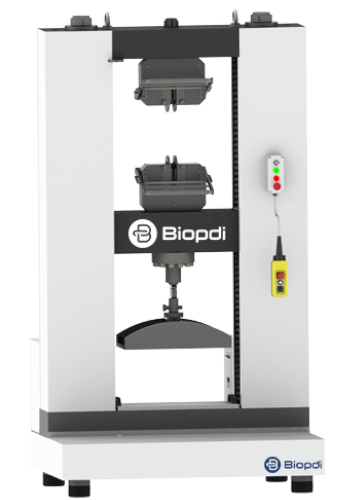
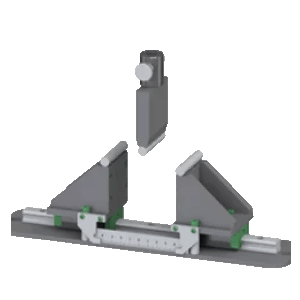
The procedure for conducting a bend test using a Universal Testing Machine
The procedure for conducting a bend test using a Universal Testing Machine (UTM) can be broken down into the following steps:
- Test Preparation: This involves preparing the test specimen according to the relevant standards (like ASTM or ISO). The sample’s dimensions should be precise, as they directly impact the calculation of results. Ensure the sample is free of any surface defects that could affect the test results.
- UTM Setup: Place the sample on the supporting anvils (two or three-point setup depending on the test standard) of the UTM, ensuring it is correctly aligned. If the specimen is not correctly placed, it could lead to erroneous results.
- Loading: Once the specimen is secured, the loading jig or mandrel, positioned at the top of the specimen, is brought down to make contact with the sample at a pre-determined speed (controlled by the UTM’s software).
- Bend Test: The UTM is then used to apply a gradually increasing load at the center of the specimen (for three-point bending), or at two points for four-point bending. The software records the force applied and the displacement of the mandrel.
- Data Analysis: The force required to fracture the specimen or the force at a specific deformation is recorded. With this data and the sample’s dimensions, calculations can be made to determine the flexural stress, strain, and modulus, among other properties. The specific calculations depend on the test standard being followed.
- Examination of the Fractured Specimen: After testing, the fractured specimen is often examined to study the characteristics of the failure. This can provide useful information about the material’s performance and potential applications.
It’s crucial to note that the exact procedure can vary depending on the material being tested, the specific test standard being followed, and the capabilities of the UTM. Always refer to the relevant standard and equipment manual for precise instructions.
The data obtained in the Bend testing using the Universal Testing Machine
Bend testing using a Universal Testing Machine (UTM) yields valuable data that provides insight into a material’s mechanical properties under bending or flexural stress. Here are some key data points typically obtained during a bend test:
- Load vs. Displacement Data: The UTM records the load applied to the specimen and the corresponding displacement (or deformation) of the specimen throughout the test. This data can be plotted to create a load-displacement curve, which shows how the material behaves under increasing load.
- Maximum Load: The maximum load that the material can withstand before failure (fracture) occurs is recorded. This value is an indication of the material’s flexural strength.
- Flexural Stress and Strain: Using the recorded load and displacement data and the initial dimensions of the specimen, the flexural stress and strain at various points during the test can be calculated.
- Flexural Modulus (Modulus of Elasticity): The slope of the initial, linear portion of the stress-strain curve represents the flexural modulus of the material. This value provides a measure of the material’s stiffness or rigidity.
- Flexural Yield Strength: For some materials, the stress at which the material begins to deform non-linearly (yielding) can be determined. This is typically more applicable to ductile materials than brittle ones.
- Fracture Characteristics: Post-test examination of the fractured specimen can provide information about the material’s fracture characteristics, such as whether the fracture was brittle (with minimal plastic deformation before failure) or ductile (with significant deformation and necking before failure).
That not all these parameters can be obtained for all materials. For example, brittle materials like ceramics and some composites do not exhibit a clear yield point or significant plastic deformation, so yield strength and ductility are not typically reported for these materials. Similarly, very ductile materials might not fracture during a bend test, so the maximum load might not be a useful parameter. The specific data obtained will depend on the material being tested and the purpose of the test.
The samples/specimens used to perform the Bend testing in the Universal Testing Machine
The samples or specimens used for bend testing in a Universal Testing Machine (UTM) can vary greatly depending on the type of material being tested and the standards being followed. However, there are some general characteristics that these specimens typically have:
- Shape and Size: Bend test specimens are typically rectangular or square in cross-section, although other shapes may be used in certain circumstances. The length, width, and thickness of the specimen will depend on the test standard, the UTM’s capacity, and the material’s properties. In many cases, the length is chosen so that the specimen spans a sufficient distance between the supporting points (or anvils) on the UTM. The width and thickness can also be important, as they affect the stress distribution within the specimen during the test.
- Surface Finish: The surface finish of the specimen can affect the test results, particularly for brittle materials where surface defects can act as stress concentrators. For this reason, the specimens are often carefully prepared to have a smooth surface finish with no visible defects.
- Material and Treatment: The specimen should be representative of the material or component being tested. This means that if the material undergoes any heat treatment or other processing in its intended application, the specimen should undergo the same treatment before testing.
- Homogeneity and Anisotropy: For materials that are homogeneous (uniform properties throughout) and isotropic (identical properties in all directions), the orientation of the specimen is not usually important. However, for non-homogeneous or anisotropic materials, such as many composites, the orientation of the specimen can significantly affect the test results, so this must be carefully controlled.
It’s important to note that the exact requirements for the test specimens, including their shape, size, surface finish, and preparation, will depend on the test standard being followed and the specific purpose of the test. Always refer to the relevant standard and/or consult with a materials testing expert to ensure the specimens are prepared correctly.
The main applications of the Bend testing
Bend testing has a wide range of applications across many industries. It serves as a quick and reliable method to evaluate the ductility and resistance to fracture of materials under bending loads. Here are some key applications of bend testing:
- Manufacturing Quality Control: In manufacturing industries, particularly where metalworking is involved, bend testing is often performed as part of routine quality control processes. This ensures the materials being used or the products being manufactured meet the required ductility standards.
- Material Selection: When designing a new product or structure, it’s critical to select materials with appropriate mechanical properties. Bend testing can provide valuable data about a material’s ductility and resistance to bending, helping engineers make informed material selections.
- Weld Inspection: Bend tests are commonly used to assess the quality of welds, particularly in industries like construction, automotive, and aerospace. The test can help detect deficiencies such as cracks, incomplete fusion, lack of penetration, or any other type of welding discontinuity that could cause the weld to fail.
- Coating and Paint Flexibility: In industries where materials are coated or painted, bend tests can be used to assess the flexibility of the coating or paint. This can help determine whether a coating will crack or peel off when the material is bent.
- Ceramics and Composites Testing: Bend testing is also important for evaluating the mechanical properties of ceramics and composite materials, which are often brittle and can fail under bending loads.
- Development and Validation of New Materials: In materials science and engineering research, bend tests are often used when developing and validating new materials. The tests can help researchers understand how a new material behaves under bending loads and compare its performance with existing materials.
Remember, the applications of bend testing can vary widely depending on the specific requirements of the industry, the material being tested, and the standards being followed.
The main standards, ISO and ASTM, for obtaining the Bend testing
Bend testing is governed by various international standards set by organizations such as the American Society for Testing and Materials (ASTM) and the International Organization for Standardization (ISO). Here are ten significant standards related to bend testing:
- ISO 7438: This ISO standard specifies the method for bend testing for metallic materials (sheet, strip, and tube) and is used for determining their flexibility or workability.
- ISO 8491: This standard provides methods for bend testing for metallic materials (thin sheet, strip, and tube). The tests defined in this standard are generally applicable to all metallic materials.
- ISO 178: This ISO standard defines the method for determining the flexural properties of plastics under defined conditions. A standard specimen is defined, and the bending stress, strain, and modulus are measured.
- ASTM E290: This is the standard test method for bend testing for material for ductility. It is applicable for metallic materials and is used to determine whether a metal exhibits the property of ductility, which is an essential characteristic for many applications.
- ASTM A370: This standard includes test methods and definitions for mechanical testing of steel products, including bend tests. It covers many types of steel and steel products.
- ASTM D790: This is the standard test method for flexural properties of unreinforced and reinforced plastics and electrical insulating materials, which may be used to measure and describe the properties of materials that could relate to bend test.
- ASTM D522: This standard measures the flexibility and adhesion of coatings on substrates by bending. It involves bending the substrate and observing the behavior of the coating, which is similar to a bend test.
- ASTM C1161: This is the standard test method for flexural strength of advanced ceramics at ambient temperature. Many ceramic samples can be quite brittle, so this test helps determine the material’s mechanical properties under bending loads.
- ASTM D671: This standard measures the flexibility of painted panels, involving bending the panel over a defined radius and observing the coating’s behavior.
The use of these standards should be determined based on the specific requirements of the material and the application, as well as the capabilities of the testing equipment.
Additional information about Bend testing.
Bend testing, while a relatively straightforward method of assessing a material’s ductility and resistance to fracture, involves many variables that can significantly affect the results. Here are some additional points that are important to keep in mind:
- Test Temperature: The temperature at which the bend test is conducted can greatly affect the results. Some materials become more brittle at low temperatures and more ductile at high temperatures. Thus, if a material is to be used in extreme temperature conditions, it’s important to conduct the bend test at those temperatures to accurately assess its performance.
- Strain Rate Sensitivity: Some materials exhibit sensitivity to the rate at which they are deformed, known as strain rate sensitivity. This means that their mechanical properties can change depending on how quickly the load is applied during the bend test.
- Material Anisotropy: Many materials, particularly those that have been processed in a certain way or are composites, exhibit anisotropic properties – their mechanical properties differ based on the direction in which they are measured. This should be taken into account when conducting and interpreting the results of a bend test.
- Material Preparation: The way in which a material is prepared prior to testing can also impact the results of a bend test. The surface finish, for instance, can play a significant role, particularly for brittle materials where surface flaws can act as points of stress concentration.
- Interpretation of Results: The results of a bend test should always be interpreted in the context of the material’s intended use. While a high degree of ductility might be beneficial for some applications, for others, a certain level of stiffness might be more desirable.
- Complementary Testing: While bend testing can provide valuable information about a material’s ductility and resistance to fracture, it should ideally be used alongside other testing methods to gain a comprehensive understanding of the material’s mechanical properties.
- Safety: During a bend test, particularly for brittle materials, there is a risk of the material fracturing and fragments being ejected at high speed. Therefore, it’s important to take appropriate safety precautions, including wearing protective equipment and using suitable shielding around the testing machine.
Bend testing is a powerful technique in materials testing, providing invaluable information about a material’s performance under bending stress. However, to ensure accuracy and reliability, it’s crucial to conduct the test correctly and take all these variables into account.
Conclusion
Bend testing, as examined in this in-depth exploration, is an indispensable tool in the realm of material science and engineering. It serves as a reliable method to assess a material’s ductility and resistance to fracture, providing critical information for material selection, manufacturing quality control, and weld inspection.
This analysis has showcased the versatility of bend testing, covering different materials like metallic, polymers, ceramics, and composites, and how each responds to this process.
The complexity of the Universal Testing Machine, the standards associated with the bend testing process, and the extensive applications of bend testing, all underscore its relevance across industries. While a powerful technique, it’s essential to keep in mind the multitude of variables affecting the test’s outcome.
From test temperature to material preparation, a multitude of factors play a crucial role in delivering accurate and reliable results. Bend testing, therefore, remains an integral part of material testing, a testament to its efficacy and adaptability in the ever-evolving landscape of material science.
FAQ
What is bend testing?
Bend testing is a type of mechanical testing that involves bending a material sample to assess its ductility, flexibility, and resistance to fracture. This test provides information about a material’s ability to withstand plastic deformation without breaking.
What are the three types of bend tests?
The three common types of bend tests are free bend, guided bend, and semi-guided bend tests.
How do you perform a bend test?
A bend test is performed using a universal testing machine or a specific bend testing machine. The test specimen is placed on the supports and a force is applied at a specific point, causing the specimen to bend. The extent and nature of the bending or fracturing are then measured and analyzed.
What is the bend test for welding defects?
The bend test for welding is used to evaluate the quality and soundness of a weld. The welded material is bent to a certain degree, and if defects like cracks or incomplete fusion are observed, it indicates that the weld is unsound.
What is the ASTM standard for bending test of steel?
The ASTM A370 is the standard for the bend test of steel, which outlines the mechanical testing of steel products.
What is the 4 point bend test ASTM?
The ASTM D6272 is the standard for the 4-point bend test. This test measures the flexural properties of plastics, including composite materials.
What does a bend test determine?
A bend test determines the ductility of a material, its resistance to fracture under bending stress, and the presence of defects in materials such as welds.
What 5 different types of bending process are there?
There are various bending processes including air bending, bottoming, coining, three-point bending, and roll bending.
What causes a bend test to fail?
A bend test can fail due to the presence of defects in the material, lack of ductility, or the material’s inability to withstand the applied bending stress.
What does the 3 point bend test determine?
The three-point bend test determines the flexural strength or the ability of a material to resist deformation under load.
How do you perform a steel bend test?
A steel bend test is performed using a universal testing machine. The steel specimen is placed on the supports and a load is applied to bend the specimen. The degree of bending and any resulting fractures are then analyzed.
What equipment is used in bend test?
The main equipment used in a bend test is a universal testing machine or a specific bend testing machine. Other equipment includes the necessary supports and anvils.
Why use a 4 point bend test?
The 4-point bend test is used as it provides a constant moment region in the material, and it can provide more accurate measurements of the material’s flexural properties.
How do you prepare for a bend test specimen?
Preparing a bend test specimen involves cutting a piece of the material of a specific size and ensuring that its surface is smooth and free from defects that could impact the test results.
What defects can a bend test show?
A bend test can show defects such as cracks, voids, inclusions, and weld discontinuities in the material.
Why is bend test recommended?
The bend test is recommended as it is a simple, cost-effective way to determine a material’s ductility, resistance to fracture, and the presence of defects.
What is the standard for bending test?
Several standards govern bending tests, such as ASTM A370 for steel, ASTM D790 for plastics, and ISO 7438 for metallic materials.
What is the bending test for rebar?
The bending test for rebar, often governed by standards such as ASTM A615 or ISO 15630-1, is used to assess the ductility and bendability of reinforcing steel bars.
What are bending tests for metals?
Bending tests for metals are used to assess the metal’s ductility or ability to deform without fracturing under bending stress. They can also reveal defects in the material.
See more relevant posts
TENSILE TEST
Tensile testing is a crucial mechanical test used to evaluate the strength and ductility of materials. It involves applying a controlled force. See more
COMPRESSION TEST
Compression testing is a fundamental evaluation method employed to assess a material's ability to withstand compressive forces. See more
SHEAR TEST
Shear testing examines a material's response to forces acting parallel to its surface. By applying a force that causes one part of the material. See more
BEND TEST
Bend testing is a mechanical test that determines a material's flexibility and resistance to fracture under bending forces. See more
FLEXURAL TEST
Flexural testing, also known as the three-point bend test, is employed to measure a material's resistance to bending or flexural stress. See more
FRICTION TEST
Coefficient of friction test measures the amount of resistance between two surfaces in contact when one moves relative to the other. See more
TEAR TEST
Tear test determines a material's resistance to tearing forces, often encountered in applications involving thin films, fabrics. See more
PEEL TEST
Peel testing evaluates the strength of adhesion between two materials, typically an adhesive and a substrate. The test involves separating. See more
BOND TEST
Bond test measures the strength of a bond between two materials. It's used in adhesive and weld test. It helps in determining the reliability of joints and interfaces. See more
INDENTATION TEST
Indentation Force Deflection (IFD) is used to characterize the cushioning or compressive properties of a material, especially foams and soft polymers. See more
FRACTURE TEST
Fracture toughness is a material's ability to resist crack propagation. This property is vital for assessing a material's suitability for applications where structural. See more
PUNCTURE TEST
Puncture test examines a material's ability to withstand penetration by sharp objects or forces. This test to evaluate puncture strength and design materials. See more
CRUSH TEST
Crush resistance test measures a material's ability to resist deformation, particularly in terms of compressive force. See more
TORSION TEST
Torsion testing is a critical method in materials engineering, examining how products and materials behave under twisting forces. See more
AXIAL TORSION TEST
Axial torsion test examines a material's behavior when subjected to simultaneous axial and torsional loads. This test to study shear stress. See more
FATIGUE TEST
Fatigue Testing is the evaluation of a material's endurance and failure under repeated stress and cyclic loading conditions. See more.

Author: Mardoqueu M. Costa (Entrepreneur, researcher and writer). I have been working for several years in materials science and engineering and biomedical engineering with emphasis on Entrepreneurship. My focus is on the development of equipment, software, mechanical tests, and the evaluation and creation of new businesses. As a researcher and writer, I have contributed to scientific publications and patents, also working as a technical-scientific consultant for several companies. This integrated approach reflects my commitment to innovation and impact in the technology industry.
Contact us
Phones:
+1 (781) 328 - 2010
sales@biopdi.com
Address:
2 Burlington Woods Dr, Burlington, Massachusetts, United States


